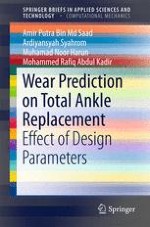2016 | Book
Wear Prediction on Total Ankle Replacement
Effect of Design Parameters
Authors: Amir Putra Bin Md Saad, Ardiyansyah Syahrom, Muhamad Noor Harun, Mohammed Rafiq Abdul Kadir
Publisher: Springer International Publishing
Book Series : SpringerBriefs in Applied Sciences and Technology
